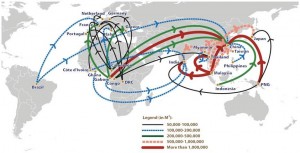
Source: Based on data from COMTRAD (2008). Diagram by CIFOR.
Note: Includes only bilateral trade flows that exceed 50,000 m3, originating from tropical forest-rich countries. The trade volumes of rough- and sawnwood have been aggregated for the purpose of this illustration.
FTA Flagship 5 research aims to (1) reveal the processes and conditions shaping trade and investment dynamics and understand their impacts on livelihoods and forests, as well as the trade-offs between the two; and (2) contribute to effective governance to manage the impacts of trade and investment. Ultimately, the goal is to lead to more sustainable and equitable development in forest-rich tropical countries. This project was previously called “The impacts of trade and investment on forests and people”.
Globalized trade and investment is a growing driver of land-use change dynamics, and thus for forest transitions over large landscapes. The consequences of trade and investment can be both negative and positive for economic development, local people’s livelihoods and the environment.
The following trends relate to trade and investment influence changes in forest landscapes:
- Growing demand for primary goods
- Increasing investment in large-scale land and forest acquisition is linked to a growing role played by transnational corporations in production
- Persistent illegal timber harvesting and trade is a lucrative global business.
These trends interact with each other in complex ways on different scales, with different implications and trade-offs for forests and people. Impacts on forests are primarily a result of shifting land-use competition dynamics. Impacts on people result from the distribution of costs and benefits associated with the land-use dynamics among the diverse stakeholders, involved in production but also in processing and trade.
In contrast, growing demand for food and biofuel crops may lead to large-scale deforestation, reducing the provision of forest goods and services, but also generating significant earnings for producer countries. In addition, large-scale acquisition of forestland to maintain carbon stocks could contribute to reducing greenhouse gas (GHG) emissions, but can also harm local people whose livelihoods depend on forest resources or conversion of forests for agricultural uses.
On the positive side, trade and investment may generate new opportunities for producer countries to enhance their capital base, expand sources of employment, increase foreign exchange earnings due to improved terms of trade in primary goods, bring about important occupational shifts and incite (agro-) industrial upgrading through technological spillovers.
On the negative side, trade and investment may also stimulate short-term economic interests leading to environmental damage, and to the concentration of land in the hands of a few large corporations. Under weak governance systems, such factors are likely to erode local people’s rights and may impose greater costs on the most vulnerable groups, such as women and indigenous peoples.
The research under Flagship 5 assesses
- the processes and mediating factors shaping trade and investment impacts across several agricultural commodities (e.g. oil crops, beef), timber, mining and carbon across specific landscapes in major tropical eco-regions in sub-Saharan Africa, the Asia-Pacific and Latin America to allow for meaningful global comparisons.
- the effectiveness of current and emerging state and non-state initiatives, processes and architectures, as part of broader governance systems and regimes, and provide options to enhance these responses.
It is structured along the themes:
1) Understanding the processes and impacts of forest-related trade and investment
2) Enhancing responses and policy options to mitigate the negative impacts and to enhance the positive impacts of trade and investment
Special attention will be given to emerging economies, bioenergy development, large-scale agribusiness investments and land acquisitions, illegal logging/timber trade, financial flows (e.g. corruption and money laundering).
There are currently no other overarching, comparative research programs that use empirical data from forest-rich landscapes to assess the nature and magnitude of trade and investment impacts across diverse spatial and temporal scales, and with a multi-commodity perspective.
